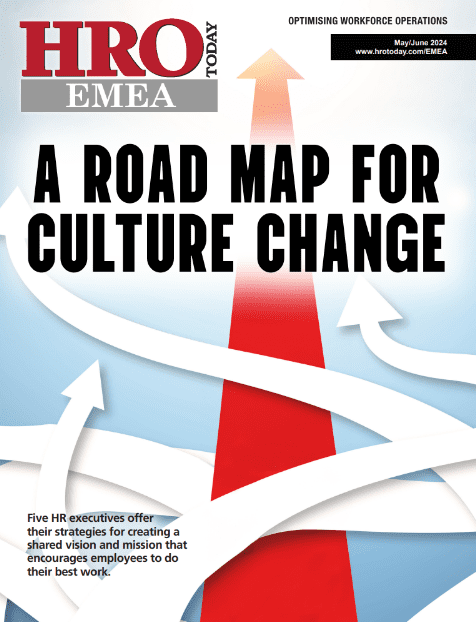AI’s impact on work-life balance, leadership, and collaboration are examined in a new KPMG study.
By Maggie Mancini
Artificial intelligence is likely to continue transforming the way people work, automating some parts of the workday so employees are freed up for more creative tasks. KPMG’s American Worker Pulse Survey 2023 finds that 75% of workers believe AI may automate some aspects of their job, while 72% of executives say that the technology may significantly alter their role. The survey indicates that middle managers will be vital to the transformation of the workforce, balancing the use of generative AI with the importance of ensuring that employees continue to feel connected to the purpose of their organization.
Felicia Lyon, principal at KPMG, says that technology is shifting how organizations think about leadership. For example, one of KPMG’s healthcare clients is concerned about the cost of healthcare and is looking to enlist employees to solve the problem. Providers are looking at how to reduce costs to serve their clients and patients. In this case, building an innovation hub with the work of the AI stewards and line of business stewards, she says, can help find solutions to drive efficiency and reduce costs.
75% of workers believe AI may automate some aspects of their job.
“That’s enlisting them in the problem,” Lyon says. “It’s aligning them to the mission and vision of the organization. This helps build trust because solving the problem regarding the mission of the company creates what I call ‘oscillating at a higher level together’ to solve the real-world problems rather than getting rid of all the jobs and automating things. If we can shift the dynamic of the manager to be more constructive than that will change the engagement scores and help keep people committed to stay.”
Work-Life Balance
While employees hope to continue prioritizing work-life balance, many are concerned that new technology will interfere with their personal time, the survey finds. In fact, 61% of executives and senior managers and 37% of middle managers say technology has had a negative impact on their work-life balance. Remote work remains a polarizing issue among HR and business professionals, with some organizations pushing for a return to in-office work while others implement more permanent remote or hybrid policies.
Workers cite reduced work weeks and more flexibility as possible solutions companies could offer to support work-life balance. Nearly half (44%) of men express a preference for working fully at the office compared to 32% of women.
“Employers can balance the needs of their workforce with the desires of their leadership by making conscious conversations, asking uncomfortable questions, and doing things with intention,” Lyon says. “We have all these modalities about how we think work should get done and that’s very old and antiquated and ripe for disruption. While COVID has been the great equalizer to help us experiment, companies should be intentional in finding out what matters to the humans within your office walls.”
For example, during the tech boom in Silicon Valley, executives were trying to get the best talent for their companies. Companies built perks around their target demographic, including having dry cleaners, chefs, and daycares on-site. For other organizations, Lyon says, this strategy could mean asking workers what they need outside of work and building resources with intention.
Collaboration
Workers believe that collaboration and teamwork will continue to grow in importance over the next three years.
“We have the textbook definitions of teamwork, but in my background and training in industrial organizational psychology, I fall back on some of those tenets about what makes a high-performing team,” Lyon says. “Just because you’re five humans working on a project together doesn’t really make you a team. Getting back to the root of a good team means creating a dynamic with intention.”
For example, KPMG did an assessment on team collaboration at the beginning of the pandemic to find tools to help people work better. The focus groups found that the company did not have the right technology to collaborate virtually, but when KPMG approached its technology team about this, they pointed out 15 tools that were provided to help facilitate collaboration.
What was missing, Lyon explains, was attempting to make the tools relevant. By explaining the technologies, what problems they solve, and how it works better at facilitating collaboration than other tools, organizations can encourage teamwork and open communication.
Job Disruption
Though most workers are aware that technology will continue to change the workforce, a quarter of KPMG’s survey respondents do not expect that AI will impact their jobs in the future. However, 42% of respondents believe that AI will cause job displacement and disruption to the workforce in the future. Some other interesting findings include the following.
- A majority (81%) remain confident that their skills will fit future jobs, but younger workers are more confident than older workers that their organizations are actively investing in reskilling to help bridge the skill gaps.
- Nearly three-quarters (74%) of respondents say their organizations will proactively invest in reskilling, and 80% believe they will do this using the latest technology.
- More than two-thirds (68%) of millennials believe that technology will enhance their productivity, with 63% of respondents from all age groups agreeing.
74% of respondents say their organizations will proactively invest in reskilling, and 80% believe they will do this using the latest technology.
Lyon cites the example of a finance colleague looking to experiment with executing quality control checks within financial data statements. Using a white-label ChatGPT model helps cleanse the data and organize it without using manpower. Employees can then analyze what that data means for the business, customers, and shareholders. By unlocking that capacity, employees are asking smart, value-added questions to propel the business, and may also open the doors to upskilling opportunities.
“In that example, we previously hired a bunch of number crunchers,” Lyon says. “Well, tomorrow we need people who have business intelligent skills and capabilities. Organizations can create an upskilling path that can chart the course for the humans doing the work in the company so that they’re developing this business intelligent mindset. They’re building this business partner muscle where they’re coaching and adding value to the business rather than spending 80% of their time creating the report. It keeps people engaged and provides them with more opportunities, and so it creates a win-win situation.”
















